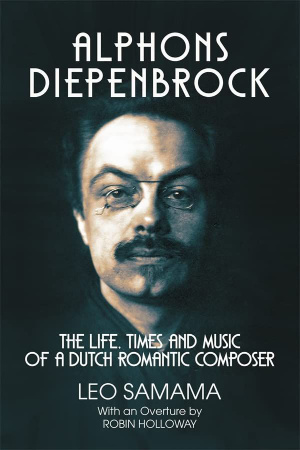
Alphons Diepenbrock – The Life, Times and Music of a Dutch Romantic Composer
by Leo Samama
433pp. Hardback
Published 2023
ISBN: 978-0-907689-61-4
Toccata Press
This welcome monograph of composer Alphons Diepenbrock first appeared in the Dutch language (Componist van het vocale) in 2012. A new translation into English by Brent Annable now makes Leo Samama’s masterly study of the composer available to non-Dutch readers.
Unusually, the book is not set out in chapters, but is rather divided into an introduction, followed by two parts. The brief introduction establishes Diepenbrock’s work in a historical context. Part 1, of about 200 pages, forms the most substantial section of the book, and is devoted to a comprehensive biography of the composer. Part 2, comprising 120 pages, focuses on Diepenbrock’s music, discussing it in detail together with many musical illustrations. There are helpful sub-headings throughout the text.
Samama opens his book by rightly pointing out that Alphons Diepenbrock “is still not a staple of modern concert programmes – not in the Netherlands, and certainly not further afield”. The bulk of his compositional output is vocal music and, with an oeuvre of around one hundred compositions, only a very small portion have no vocal part or text. The pinnacle of his achievements are the Missa in die festo and the Te Deum. There are numerous songs, both orchestrated and with piano accompaniment, some a cappella works and a handful of stage scores. His orchestral music consists of the Marsyas Concert Suite, Overture The Birds and the Symphonic Suite Elektra. Samama goes on to say that the composer “wrote no symphonies, string quartets or piano sonatas, and therefore appealed primarily to the niche audience made up of lovers of vocal music”. Later in the book he concludes that “regardless of the masses of energy he devoted to composition, he really cannot be viewed as anything other than a hobbyist composer”. The author states that Diepenbock was the victim of indecisiveness all of his life and, as a consequence, his works never received their due worth.
Alphons Diepenbrock was born in Amsterdam in 1862 into a well-heeled Catholic family. As a child he showed musical ability, yet it was expected that he would enter a university rather than a conservatory. So, at the University of Amsterdam he studied classics and obtained a doctorate cum laude in 1888 with a dissertation in Latin on the life of Seneca. He went into teaching as a classics tutor and published works throughout his life on literature, painting, politics, philosophy and religion. In 1895 he married Wilhelmina Elisabeth Cornelia Petronella de Jong van Beek en Donk. The couple had two daughters, Johanna (born 1905) and Dorothea (born 1907). Diepenbrock died of liver cancer in 1921.
Early on he made the decision to devote his life to music and, as a composer, was completely self taught. He started directing vocal ensembles and came to the realization that some education in conducting was necessary. In addition to observing conductors in rehearsal, he read Felix Weingartner’s Über das dirigieren, a groundbreaking treatise on conducting.
As far as influences were concerned, Diepenbrock studied the scores of Wagner and was equally drawn towards Early Music, especially that of Palestrina. Samama aptly sums up these influences: “ His blending of Palestrinian counterpoint with the melodic and harmonic chromaticism of Wagner, supported later with elements of Debussy’s more ethereal soundworld are what makes Diepenbrock’s music so characteristic”. Added to that, his vocal compositions are esteemed for the high quality of the texts employed. Diepenbrock drew from the works of Goethe, Novalis, Vondel, Brentano, Hölderlin, Heine, Nietzsche, Baudelaire and Verlaine, in addition to Ancient Greek dramatists and the Roman Rite of the Catholic Church.
As a much-respected figure amongst musical circles, Diepenbrock formed close friendships with the likes of Gustav Mahler and Arnold Schoenberg. Throughout the book, his opinions of other composer’s music is discussed in detail. In 1899, Willem Mengelberg conducted Richard Strauss’ Ein Heldenleben. It came under scathing criticism from Diepenbrock, who described it as “of a paucity and dryness and banality of conception”, pillorying especially “a nonsensical violin solo (completely unaccompanied)”. He went on to lambast it as “empty and arid and of a desperate vulgarity, lacking a single pure melody……”. This same lack of melody was the focus of his criticism of Debussy’s Pelléas et Mélisande, with its “monotonous orchestration (endless muted strings and oboes)”. Regarding the deathbed scene, he found this “the most nauseating. The music is utterly emaciated…… for four uninterrupted hours I cannot endure it”.
The composer’s relationship with Johanna Jongkindt (1882-1945) is discussed at some length. She initially approached Diepenbrock in early 1904 for Greek lessons. She was also an accomplished pianist. Over the next few years the two became lovers and, though separated for much of the time, they amorously corresponded a great deal. Diepenbrock never left his wife and Jongkindt later married.
This is an extensively researched book, which makes for an absorbing and enlightening encounter. I thoroughly enjoyed it and found it a rewarding read. I’m very impressed with Toccata Press’ production values, and must single out for special mention the book’s clear and readable print. The appendices, of which there are two, are valuable indeed. One is a chronological list of the composer’s works, whilst the other is a list of Diepenbrock’s “Articles and Submissions”. The bibliography, which follows, is comprehensive. The book concludes with a detailed general index. The icing on the cake is a veritable galaxy of fascinating and well-chosen black and white photographs. In short, this superb publication deserves the attention of all who have a lively interest in Dutch music. All credit to Leo Samama and Toccata Press.
Stephen Greenbank
Help us financially by purchasing from




















